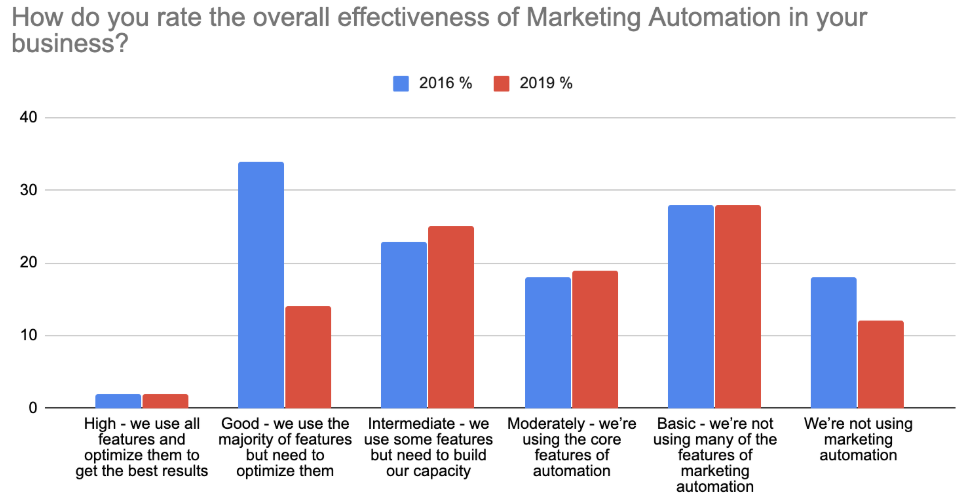We worked with Smart Insights to understand the state of marketing automation within business. This was a follow-up to the same study that was done in 2016.
| Year | Number of Respondents |
| 2019 | 308 |
| 2016 | 433 |
How do you rate the overall effectiveness of Marketing Automation in your business?
In 2015, we found that around 24% were not using marketing automation which had dropped to 18% in 2016. In 2019 and we still saw around one in eight were not using marketing automation at all with only 28% not using many features of marketing automation – the same percentage as 2016.

Which of these automated email marketing techniques do you use?
There are similarities between 2016 and 2019 in that the initial welcome sequence remains the most popular of the automated email marketing techniques, despite use dropping from 68% in 2016 to 62% in 2019. Nurturing emails were the second most popular technique in 2019, whereas this was the up-sell in 2016. It still shows many businesses not using the advanced techniques email marketing can offer, which may fall in line with the fact that progressive profiling has actually dropped from 23% to 18% use.

Rate the level of email targeting you use
One of the key outtakes here is that 29% of companies still said they weren’t using any targeting at all, down by just one percent since 2016. It suggests there remains a knowledge shortage of either the effectiveness of targeting or how to go about targeting users based on their profile. There were marginal increases in two to five segments targeted (up to 42% in 2019 from 39% in 2016) and in five or more segments targeted (up to 14% from 12% in 2016). The biggest change we saw was 18% of those asked said they nurtured emails based on lead score, compared with 4% in 2016.

Which of these lead-scoring techniques do you use?
The most common lead scoring techniques in 2019 were links clicked in email and content visited on the website, which is what the study in 2016 also showed. This is positive, considering both of these are powerful techniques to assess engagement and align follow-up communication.‘Engagement level based on length of time or frequency of use’ was similar in both studies, suggesting that respondents still don’t quite understand the power of how this can be used to define more accurate lead scoring. We saw a huge drop in “profile field fit with ideal target customers” (down from 32% in 2016 to 19% in 2019), despite it being one of the best practice lead scoring techniques.

Please rate these activities for their relative ROI expected for your business in 2019.
This study wasn’t taken in 2016. AI is still relatively new to the market and not yet that cost-effective so it is little surprise that the uptake of this has been so small. Landing pages for lead capture and A/B testing have increased in use across the last three years (not referenced in this study) and use has largely been “moderately effective”. As respondents better understand how to get the most out of these techniques, then we may see effectiveness increase in future studies.

What are the biggest barriers to adoption of marketing automation functionality.
The notable drop-off here is that limited staff knowledge or skill has dropped from 55% to 49%, as more knowledge has become publicly available around setting up rules, lead scoring and sequences, though it remains a significant barrier to entry.
This is also the case for “defining a strategy for marketing automation” (dropping from 43% in 2016 to 37% in 2019), more knowledge in the market makes defining the strategy easier. There are consistencies with the results from 2016 to 2019 in that “integrating data from different sources and systems” (56%) and “lack of resources to manage implementation of features” (54%) remain big barriers to marketing adoption.
 Which persuasive techniques do you use to encourage email sign-up?
Which persuasive techniques do you use to encourage email sign-up?
This wasn’t asked in 2016. It’s little surprise that a direct call-to-action sign-up message on key pages is the most popular method of persuasion to encourage email sign-up with 56% of respondents using this, though a little surprising it wasn’t used by more. Access to reports remain popular but again it’s a little surprising that more than 44% of respondents use this technique. Tests at Smart Insights showed that lightboxes were proven to increase leads by double digits even with other persuasive sign-up techniques were visible, so better communication may permit more than the 22% of respondents to use this technique in the future.

Further Reading






